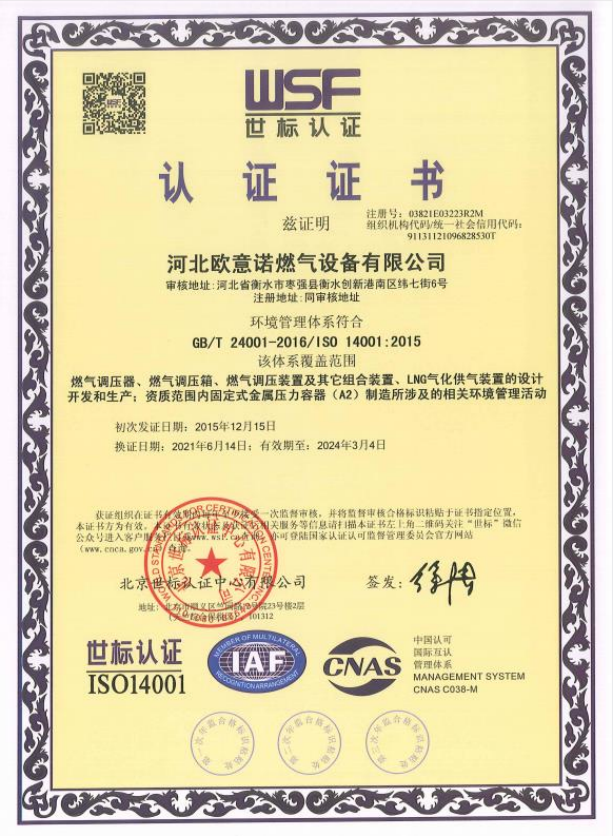
Dec . 14, 2024 12:44
Back to list
Understanding Functionality and Application of Gas Pressure Regulation Valves
Understanding Gas Pressure Regulator Valves A Comprehensive Guide
Gas pressure regulator valves play a critical role in various industries, ensuring the safe and efficient use of gaseous substances. From residential to industrial applications, these devices are essential for maintaining consistent gas pressure, which is vital for the proper operation of heating systems, cooking appliances, and industrial machinery. In this article, we will delve into the functionality, types, and applications of gas pressure regulator valves.
What is a Gas Pressure Regulator Valve?
A gas pressure regulator valve is a mechanical device designed to control the pressure of gas within a system. Its primary function is to reduce the high inlet pressure from a gas source (such as a pipeline or tank) to a lower, stable outlet pressure that can be safely used by appliances or equipment. By regulating gas pressure, these valves prevent damage to appliances, enhance safety, and ensure optimized performance.
How Does a Gas Pressure Regulator Work?
The operation of a gas pressure regulator is relatively straightforward. The valve consists of a spring-loaded diaphragm, which moves in response to changes in pressure. When gas enters the regulator, it exerts pressure on the diaphragm. If the inlet pressure exceeds the desired outlet pressure, the diaphragm moves to close the valve, thereby reducing the flow of gas. Conversely, if the outlet pressure drops below the set point, the diaphragm allows more gas to flow through the valve. This feedback mechanism ensures that the outlet pressure remains within a specified range, adapting to varying flow conditions.
Types of Gas Pressure Regulators
There are several types of gas pressure regulators, each designed for specific applications and pressure requirements
1. Single-stage Regulators These are ideal for low-pressure applications where the required outlet pressure is significantly lower than the inlet pressure. They provide a cost-effective solution for residential gas appliances.
2. Multi-stage Regulators These regulators are designed for applications where the pressure drop from inlet to outlet is substantial. By breaking down the pressure reduction into multiple stages, they can provide more precise control and reduce the risk of pressure fluctuations.
gas pressure regulator valve

3. Back-pressure Regulators These devices are used to maintain a specific pressure in a flow system by allowing gas to vent back to a source when necessary. They are commonly found in applications where pressure stability is critical.
4. Dome-loaded Regulators These regulators use a diaphragm and an external pressure source (the “dome”) to control outlet pressure. This design is often used in more complex systems where precise control is required.
Applications of Gas Pressure Regulators
Gas pressure regulators are employed in a wide variety of applications, including
- Residential Heating In home heating systems, regulators ensure that natural gas is delivered at a consistent pressure to furnaces and boilers for efficient operation.
- Cooking Appliances Gas stoves and ovens rely on pressure regulators to maintain the correct pressure for safe and effective cooking.
- Industrial Processes Many manufacturing processes require precise gas pressure control for combustion, chemical processing, or feedstock preparation. Regulators contribute to operational efficiency and safety in these environments.
- Medical Applications In medical facilities, gas pressure regulators are critical for delivering gases such as oxygen and nitrous oxide to patients at safe and controlled pressures.
Conclusion
Gas pressure regulator valves are vital components in the safe and efficient management of gas systems across various industries. By maintaining stable outlet pressures, these devices play an essential role in ensuring the functionality and safety of gas-powered appliances and equipment. Understanding the types and applications of gas pressure regulators can help users select the right device for their specific needs, ultimately leading to improved performance and safety in gas utilization. As technology advances and industries evolve, the role of gas pressure regulators will continue to be fundamental in adapting to new challenges and opportunities.
Next:
Latest news
-
Safety Valve Spring-Loaded Design Overpressure ProtectionNewsJul.25,2025
-
Precision Voltage Regulator AC5 Accuracy Grade PerformanceNewsJul.25,2025
-
Natural Gas Pressure Regulating Skid Industrial Pipeline ApplicationsNewsJul.25,2025
-
Natural Gas Filter Stainless Steel Mesh Element DesignNewsJul.25,2025
-
Gas Pressure Regulator Valve Direct-Acting Spring-Loaded DesignNewsJul.25,2025
-
Decompression Equipment Multi-Stage Heat Exchange System DesignNewsJul.25,2025

